List of all Five Year Plans of India PDF Download
Today we will share the List of all Five Year Plans of India PDF Download, Objectives, Events, List of all Five Year Plans of India Goals and achievements, etc, and you can download this page as a PDF in All Languages in 1 click (ICON: see on your right Top side), just go to the end of this page you will get a PDF Download Button and this PDF is very important for your Upcoming Exams like UPSC, SSC, TEACHING, POLICE, BANK, etc.
- India’s post-independence era was marked by visionary planning, strategic foresight, and ambitious goals. At the heart of this economic roadmap were the Five-Year Plans, meticulously designed frameworks that steered India’s development trajectory. Spanning over six decades, these plans played a pivotal role in shaping the nation’s economy, infrastructure, and social fabric. This article delves into the transformative journeys of India’s Five-Year Plans, tracing their evolution and impact on the country’s growth and progress.
The Evolution of India’s Five-Year Plans: A Journey Towards Development
India’s Five-Year Plans have played a pivotal role in shaping the country’s economic landscape since its independence in 1947. Conceived with the vision of achieving self-sufficiency and economic prosperity, these plans have evolved over the years to address the changing needs of a rapidly growing nation. In this article, we will delve into the history, objectives, and impact of India’s Five-Year Plans, highlighting their significance in the country’s development journey.
Historical Background:
- The concept of Five-Year Plans was borrowed from the Soviet model of economic planning. India’s first Prime Minister, Pandit Jawaharlal Nehru, introduced the planning system in 1951 with the aim of accelerating economic growth and improving the living standards of its citizens. The planning process was designed to achieve specific targets within a fixed timeframe of five years, ensuring a systematic approach to development.
Objectives of the Five-Year Plans
Objectives of five-year plans are given below:
- Growth of economy
- Economic equity and social justice
- Full employment
- Economic self-reliance
- Modernization of the economy
The primary objectives of India’s Five-Year Plans were multi-faceted:
- Economic Growth: The plans aimed at promoting rapid economic growth by focusing on various sectors such as agriculture, industry, and services.
- Employment Generation: Creating employment opportunities for the burgeoning population was a crucial goal. The plans aimed to reduce unemployment and underemployment by fostering industrialization and infrastructure development.
- Poverty Alleviation: Poverty eradication was a key focus, with initiatives aimed at improving the living standards of the marginalized sections of society through targeted welfare programs.
- Infrastructure Development: Building a robust infrastructure was vital for economic progress. Investments were made in areas like transportation, energy, and telecommunications to support industrial growth and urbanization.
- Self-Reliance: The plans aimed at reducing dependence on foreign aid and achieving self-sufficiency in essential commodities and technology.
Key Achievements and Challenges:
- Over the years, India’s Five-Year Plans achieved significant milestones. During the early plans, there was a focus on agrarian reforms and the establishment of basic industries. In subsequent plans, there was an emphasis on technological advancements, education, and healthcare. The Green Revolution and White Revolution, implemented during these plans, transformed the agricultural and dairy sectors, ensuring food security and increased income for farmers.
- However, the plans were not without challenges. Bureaucratic hurdles, inadequate implementation, and lack of resources often hampered the effective execution of planned programs. Moreover, the changing global economic scenario necessitated revisions and adaptability in subsequent plans.
Post-Liberalization Era:
- In 1991, India embraced economic liberalization, opening its doors to globalization and foreign investments. This shift marked a significant departure from the earlier planned economic model. While the Five-Year Plans continued, their focus shifted towards more targeted and outcome-based planning. The emphasis moved from centralized planning to decentralized planning, empowering states and local bodies to tailor development strategies according to their specific needs.
Conclusion:
- India’s Five-Year Plans have been instrumental in steering the nation towards progress and prosperity. They laid the foundation for key sectors, created jobs, and improved the overall quality of life for millions. As India continues its journey towards becoming a global economic powerhouse, the lessons learned from these plans remain invaluable. While the formal Five-Year Plans have been discontinued, the spirit of planned development lives on in various government initiatives, ensuring that the country’s growth trajectory remains steady and inclusive.
Also read: SlideSharePPT
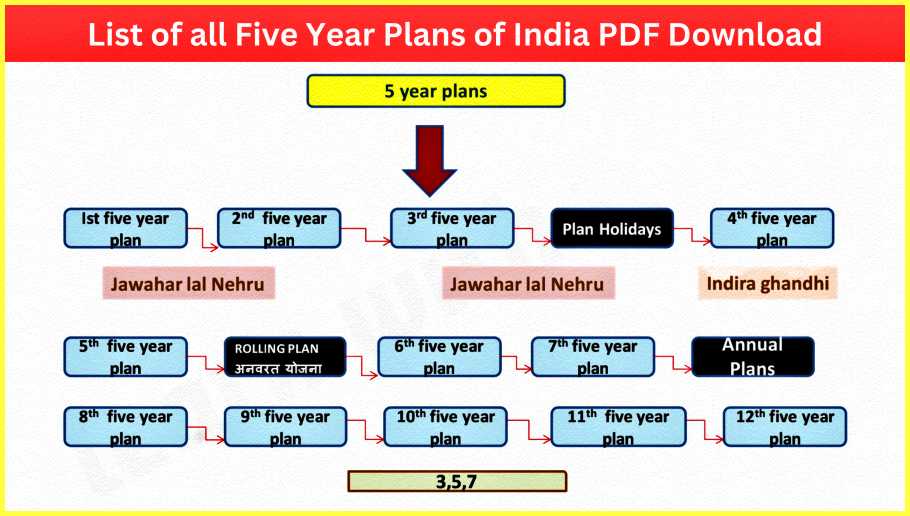
Table: Chronology of India’s Five-Year Plans (1951-2017)
Here is a table summarizing the Five-Year Plans in India from 1951 to 2017:
| Five-Year Plan | Duration | Focus Areas |
|---|---|---|
| First Five-Year Plan | 1951-1956 | Agriculture, Irrigation, Power, Education, and Health. |
| Second Five-Year Plan | 1956-1961 | Heavy Industries, Basic Industries, and Transport. |
| Third Five-Year Plan | 1961-1966 | Self-reliance and Agriculture Development. |
| Three Annual Plans | 1966-1969 | Rehabilitation and Development after the Indo-Pakistani War of 1965. |
| Fourth Five-Year Plan | 1969-1974 | Growth with Stability and Progress towards Self-Reliance. |
| Fifth Five-Year Plan | 1974-1979 | Poverty Eradication, Employment Generation, and Rural Development. |
| Sixth Five-Year Plan | 1980-1985 | Accelerated Economic Growth, Modernization, and Technology. |
| Seventh Five-Year Plan | 1985-1990 | Human Resource Development, Employment, and Rural Development. |
| Eighth Five-Year Plan | 1992-1997 | Social Justice, Economic Growth, and Modernization. |
| Ninth Five-Year Plan | 1997-2002 | Education, Health, Agriculture, and Rural Development. |
| Tenth Five-Year Plan | 2002-2007 | Infrastructure Development, Education, and Healthcare. |
| Eleventh Five-Year Plan | 2007-2012 | Inclusive Growth, Infrastructure, and Social Development. |
| Twelfth Five-Year Plan | 2012-2017 | Faster, More Inclusive, and Sustainable Growth. |
Please note that there is no specific plan designated as the Thirteenth Five-Year Plan as the government of India decided to discontinue the planning commission after the Twelfth Five-Year Plan period.
What is the History of Five-Year Plans?
In the aftermath of gaining independence, India faced the daunting challenge of rebuilding its economy and steering the nation towards progress. The concept of planning as a methodical approach to economic revival gained prominence during the 1940s and 50s. This pivotal period witnessed the collaborative efforts of various industrialists who recognized the significance of planning for India’s post-independence trajectory. In 1944, these visionary minds converged to draft a seminal proposal known as the Bombay Plan. This document laid the foundation for setting up a planned economy in India, serving as a guiding light for the nation’s economic architects.
The Crucial Choice: Planning for Development
- Following the jubilation of independence, India stood at a crossroads, facing critical decisions that would shape its future. One of the pivotal choices confronting the newly independent nation was the implementation of a comprehensive plan for development. Recognizing the imperative nature of this decision, India embraced the idea of planning for economic growth and social progress. Planning became more than just a strategy; it became a symbol of India’s determination to elevate the living standards of its people, eradicate poverty, and create a robust foundation for the generations to come.
The Soviet Influence: Introduction of the Five-Year Plan
- In the global landscape, the Soviet Union emerged as a trailblazer in economic planning. Joseph Stalin, the leader of the Soviet Union, pioneered the concept of Five-Year Plans in 1928. This innovative approach involved setting specific economic targets and goals for a five-year period, providing a structured framework for development. The successful implementation of these plans in the Soviet Union served as a beacon of inspiration for nations worldwide, including India.
India’s Leap: Launching the Five-Year Plans
- Taking cues from the Soviet Union’s successful model, India embarked on its own journey of economic transformation through the introduction of the Five-Year Plans. These meticulously crafted plans, initiated after independence, aimed to propel India’s economy forward and foster sustainable development. Through a series of Five-Year Plans, India channeled its resources, manpower, and intellect into key sectors, striving to achieve self-reliance, technological advancement, and social progress. Each plan represented a step forward, marking significant milestones in India’s growth story and laying the groundwork for the nation’s emergence as a global economic powerhouse.
In summary, the history of Five-Year Plans in India is a testament to the nation’s resilience, vision, and commitment to progress. Rooted in the ideals of economic reconstruction and social upliftment, these plans became instrumental in shaping India’s destiny, fostering innovation, and laying the foundation for a brighter future.
Understanding the Concept of Five-Year Plans (FYPs)
The concept of Five-Year Plans (FYPs) in India revolves around a straightforward idea: the Government of India meticulously outlines its financial framework, encompassing both income and expenditure, for a span of five years. This strategic document serves as a comprehensive roadmap, guiding the nation’s economic decisions and initiatives over the specified period. To facilitate effective financial management, the budgets of both the central government and state governments are bifurcated into two distinct categories: the non-plan budget and the plan budget.
Budget Division: Non-Plan and Plan Budgets
- Within the budgetary framework, the non-plan budget caters to routine expenditures incurred on an annual basis. These routine expenses are essential for the day-to-day functioning of the government. In contrast, the planned budget operates on a five-year cycle, aligning with the overarching priorities set by the nation’s comprehensive plan. This planned expenditure is strategically allocated to specific sectors and projects, aiming to foster economic growth, infrastructural development, and social progress.
The Evolution: Indian Economy and Five-Year Plans (1951-2017)
- The foundation of the Indian economy, for several decades, was built upon the principles of planning, chiefly through the implementation of Five-Year Plans. These plans, spanning from 1951 to 2017, were instrumental in shaping India’s economic landscape. The strategic allocation of resources and funds according to the priorities outlined in these plans played a pivotal role in India’s developmental journey.
Institutional Mechanisms: Planning Commission to NITI AAYOG
- To oversee the formulation, implementation, and regulation of the Five-Year Plans, the Indian government established the Planning Commission. This body served as the driving force behind India’s planned economic development for many years. However, in 2015, the Planning Commission underwent a transformative change, giving rise to a new institutional framework known as NITI AAYOG. As the successor to the Planning Commission, NITI AAYOG emerged as a think tank, ushering in innovative strategies and fresh perspectives to address the challenges of the contemporary economic landscape.
NITI AAYOG’s Vision: A Comprehensive Approach
- Under the umbrella of NITI AAYOG, India’s economic planning took a multi-faceted turn. NITI AAYOG introduced three essential documents that encapsulate India’s vision for the future. These documents include the 3-year action agenda, the 7-year medium-term strategy paper, and the 15-year vision document. Each of these documents reflects a comprehensive approach to planning, encompassing short-term goals, medium-term strategies, and a long-term vision, thereby ensuring a well-rounded and forward-looking developmental trajectory for the nation.
In essence, the concept of Five-Year Plans and the evolution of planning mechanisms in India signify the nation’s adaptability and commitment to fostering sustained economic growth and societal progress. These plans, whether in their traditional form or as envisioned by NITI AAYOG, continue to serve as cornerstones in India’s developmental endeavors, shaping the country’s future in a dynamic and ever-changing global landscape.
TABLE: Evolution of India’s Five-Year Plans: Objectives, Assessments, and Achievements (1951-2017)
Here is the Table:
| Five-Year Plans (Years) | Assessment | Objectives | Key Initiatives and Achievements |
|---|---|---|---|
| First Five-Year Plan (1951-1956) | Targets and objectives are more or less achieved. Five Indian Institutes of Technology (IITs) were established. | – Rehabilitation of refugees.
– Rapid agricultural development for food self-sufficiency. – Control of inflation. |
– Establishment of five IITs.
– Active state involvement in economic sectors. – Focus on agricultural development. |
| Second Five-Year Plan (1956-1961) | Partial implementation due to forex shortage. Established Hydroelectric power projects and steel mills. | – Rapid industrialization with emphasis on basic and heavy industries.
– Adoption of the Nehru-Mahalanobis model. |
– Initiation of Hydroelectric power projects.
– Establishment of steel mills at Bhilai, Durgapur, and Rourkela. |
| Third Five-Year Plan (1961-1966) | Faced challenges due to wars and droughts. Initiated Panchayat elections. | – Establishment of a self-reliant and self-generating economy. | – Initiation of Panchayat elections.
– Formation of State Electricity Boards and State Secondary Education Boards. |
| Plan Holidays (1966-1969) | Implemented new agricultural strategies, addressing food shortage. | – Addressing the agriculture crisis and serious food shortage issues. | – Introduction of new agricultural strategies.
– Distribution of high-yielding seed varieties and extensive use of fertilizers. – Exploitation of irrigation potential and soil conservation measures. |
| Fourth Five-Year Plan (1969-1974) | Ambitious but marred by inflation. Nationalization of major banks. Green Revolution advanced agriculture. | – Achieve ‘growth with stability’.
– Progressive achievement of self-reliance. – “Garibi Hatao” (Remove Poverty) campaign. |
– Nationalization of 14 major Indian banks.
– Advancement of Green Revolution in agriculture. – Achieved a growth rate of 3.5%. |
| Fifth Five-Year Plan (1974-1979) | Terminated due to high inflation. Introduced the Indian national highway system. | – Remove poverty and attain self-reliance. | – Introduction of Indian National Highway System.
– Efforts to remove poverty and achieve self-reliance. |
| Sixth Five-Year Plan (1980-1985) | Most targets achieved, including 5.5% growth. Expanded family planning efforts. | – Direct attack on poverty through economic expansion. – Expansion of family planning efforts. | – Achieved a 5.5% growth rate.
– Expansion of family planning programs. – Focus on poverty alleviation through economic expansion. |
| Seventh Five-Year Plan (1985-1990) | Successful despite droughts. Introduced programs like Jawahar Rozgar Yojana. | – Emphasis on policies accelerating food chain production, employment, and productivity. | – Introduction of Jawahar Rozgar Yojana.
– Policies to accelerate foodgrains production. – Achieved a growth rate of 6%. |
| Annual Plans (1989-1991) | Beginning of privatization and liberalization in India. | – Economic reforms and liberalization policies. | – Initiation of privatization and liberalization policies.
– Focus on economic reforms and opening up of the economy. |
| Eighth Five-Year Plan (1992-1997) | Partial success with an average annual growth rate of 6.78%. | – Rapid economic growth.
– High growth of agriculture and allied sectors. – Improvement in trade and current account deficit. |
– Achieved an average annual growth rate of 6.78%.
– Growth in agriculture and allied sectors. – Improvement in trade and current account deficit. – Focus on rapid economic growth and trade improvement. |
| Ninth Five-Year Plan (1997-2002) | Achieved 5.4% GDP growth, lower than the target. Focused on quality of life, employment, and self-reliance. | – Growth with social justice and equality.
– Regional balance and self-reliance. – Targeted growth rate of 6.5%. |
– Achieved a GDP growth rate of 5.4%.
– Emphasis on social justice, equality, and self-reliance. – Focus on regional balance and employment generation. – Achieved an average annual growth rate of 6.7%. |
| Tenth Five-Year Plan (2002-2007) | Reduced poverty by 5%, increased forest cover to 25%, and achieved over 8% economic growth. | – Achieve 8% GDP growth.
– Reduce poverty by 5 points. – Increase literacy rate in the country. |
– Reduction of poverty by 5%.
– Increase in forest cover to 25%. – Achieved over 8% economic growth. – Focus on poverty reduction, literacy improvement, and environmental conservation. |
| Eleventh Five-Year Plan (2007-2012) | Recorded 8% economic growth. Focused on inclusive growth, education, gender equality, and environmental sustainability. | – Rapid and inclusive growth.
– Empowerment through education and skill development. – Reduction of gender inequality. |
– Achieved an average annual economic growth rate of 8%.
– Focus on empowerment through education and skill development. – Initiatives to reduce gender inequality. – Focus on environmental sustainability and conservation. |
| Twelfth Five-Year Plan (2012-2017) | Targeted 8% growth, emphasizing sustainable and inclusive growth. Aimed at increasing agriculture output and manufacturing. | – Faster, more sustainable, and more inclusive growth.
– Raise agriculture output to 4%. – Achieve 10% growth in the manufacturing sector. – Environmental conservation and sustainability. |
– Focus on faster and more inclusive growth.
– Emphasis on raising agriculture output. – Achieving growth in the manufacturing sector. – Development of power generation capacity. – Initiatives for environmental conservation and sustainable growth. |
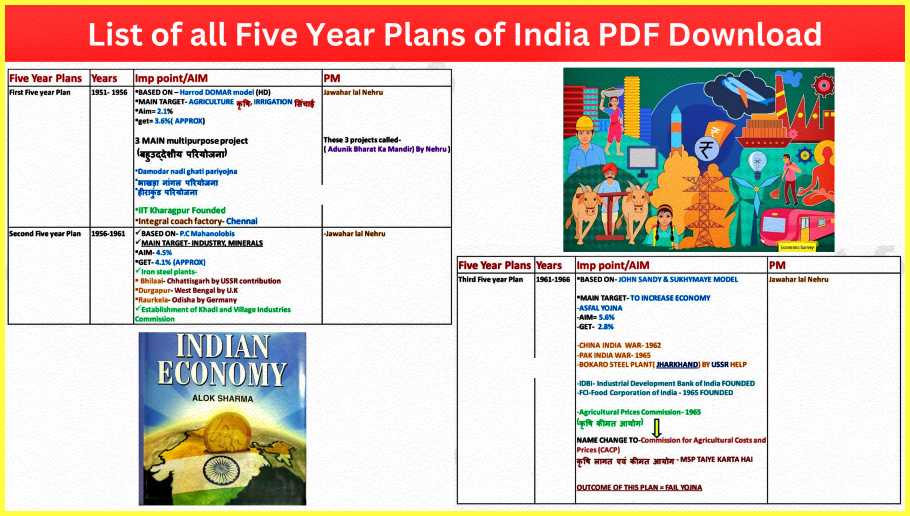
Understanding India’s Five-Year Plans: A Historical Overview
The Five-Year Plans in India, a series of meticulously crafted economic blueprints, have played a pivotal role in shaping the nation’s developmental trajectory. Each plan was characterized by its unique objectives, purposes, and targets, contributing to India’s progress over the years. Let’s delve into the details of each of these plans to comprehend their objectives and the actual growth they achieved.
First Five-Year Plan: Nurturing the Primary Sectors
The inaugural First Five-Year Plan, spanning from 1951 to 1956, was spearheaded by India’s first Prime Minister, Jawaharlal Nehru. The primary focus of this plan was the development of fundamental sectors, with a strong emphasis on agriculture. During this period, India also witnessed the establishment of five prestigious Indian Institutes of Technology (IITs). The plan was primarily based on the Harrod-Domar model, with slight modifications, and aimed to lay a strong foundation for India’s economic growth.
Here’s an expanded and more informative version of the table for the First Five-Year Plan in India, incorporating additional context:
| Aspect | Details |
|---|---|
| Duration | 1951-1956 |
| Prime Minister | Jawaharlal Nehru, India’s first Prime Minister, presented the plan to the Indian Parliament. |
| Planning Paradigm | The plan was primarily based on the Harrod-Domar model, emphasizing investment in key sectors to spur economic growth. |
| Total Plan Budget | The total budget allocated for the plan was Rs. 2069 crore (equivalent to approximately $2378 crore during that time). |
| Allocation Emphasis | The plan focused on seven significant categories, with special emphasis on agriculture, transportation, and communications infrastructure. |
| Key Initiatives | – Agriculture: Introducing land reforms, improving irrigation facilities, and providing agricultural credit to enhance agricultural productivity.
– Transportation: Developing road and rail networks to facilitate the movement of goods and people across the country. – Communications: Investing in the expansion of telecommunication infrastructure to connect remote areas. – Education: Strengthening the educational system to foster human capital development. |
| Achievements | One of the notable outcomes was the establishment of five prestigious Indian Institutes of Technology (IITs) in 1956, marking a significant step in technological education and research in India. |
| Targeted Growth Rate | The plan aimed for a growth rate of 2.1%, reflecting the ambitious economic targets set to boost the nation’s development. |
| Achieved Growth Rate | The plan exceeded expectations, achieving a growth rate of 3.6%, indicating successful implementation of planned initiatives. |
| Legacy | The First Five-Year Plan laid the foundation for India’s economic development post-independence, emphasizing self-sufficiency, industrial growth, and investment in human capital. It set the stage for subsequent plans, shaping the trajectory of India’s economy and technological advancements. |
The First Five-Year Plan played a pivotal role in shaping India’s development landscape, fostering the growth of key sectors and institutions that continue to contribute significantly to the country’s progress.
Second Five-Year Plan: A Leap Towards Industrialization
Continuing under the leadership of Jawaharlal Nehru, the Second Five-Year Plan (1956-1961) shifted its attention to the industrial sector. While the target growth rate was set at 4.5%, the achieved growth rate stood at 4.27%. The plan was formulated based on the P.C. Mahalanobis Model in 1953. Challenges arose due to India’s payment issues in 1957, leading experts to question the feasibility of the set growth targets.
Here’s the information presented in the form of a table for the Second Five-Year Plan in India:
| Aspect | Details |
|---|---|
| Duration | 1956-1961 |
| Prime Minister | Jawaharlal Nehru continued to lead the implementation of the Second Five-Year Plan. |
| Planning Model | The plan was based on the PC Mahalanobis Model, emphasizing industrial growth and economic development. |
| Main Objective | The primary focus of the plan was to promote rapid industrialization across various sectors of the economy. |
| Challenges and Criticisms | The plan faced criticism from experts, and in 1957, India experienced a payment problem, highlighting challenges in implementation. |
| Targeted Growth Rate | The plan aimed for a growth rate of 4.5%, reflecting the ambitious industrialization goals set for the nation. |
| Achieved Growth Rate | The plan achieved a growth rate of 4.27%, slightly below the targeted rate, indicating progress in industrial development despite challenges. |
| Key Initiatives | – Industrial Growth: Emphasized the expansion of heavy industries, chemical plants, and manufacturing sectors to boost economic output.
– Infrastructure Development: Invested in the development of infrastructure, including power generation, transportation, and telecommunications. – Technology and Research: Encouraged scientific research and technological advancements to enhance industrial capabilities. |
| Legacy | Despite challenges and criticisms, the Second Five-Year Plan laid the groundwork for India’s industrial growth, paving the way for the country’s economic transformation in subsequent years. It highlighted the importance of industrial development in achieving self-reliance and economic stability. |
The Second Five-Year Plan played a crucial role in India’s industrialization efforts, setting the stage for the country’s economic progress and emphasizing the significance of a robust industrial base for future development.
Third Five-Year Plan: Striving for Self-Reliance
The Third Five-Year Plan, under the leadership of Lal Bahadur Shastri, aimed to bolster India’s self-reliance and self-sufficiency. Notably, the plan emphasized the importance of agricultural progress, with a focus on increasing wheat production and the introduction of the Green Revolution. Unfortunately, this plan faced severe setbacks, including India’s involvement in the Sino-India conflict of 1962 and the Indo-Pakistani war of 1965, leading to economic vulnerability and price destabilization.
Here’s the information presented in the form of a table for the Third Five-Year Plan in India:
| Aspect | Details |
|---|---|
| Duration | 1961-1966 |
| Prime Minister | Jawaharlal Nehru continued to lead the implementation of the Third Five-Year Plan. |
| Planning Model | The plan was developed under the direction of Jawaharlal Nehru and was known as the Gadgil Yojana, named after the Planning Commission’s deputy chairman, Dr. Gadgil. |
| Main Goal | The primary objective of the plan was to achieve economic autonomy, with a focus on making the economy self-sufficient. |
| Priority Sector | The agricultural industry, particularly wheat production, was prioritized to enhance food security and agricultural output. |
| Challenges Faced | India faced significant challenges during the plan period, including the Sino-Indian War in 1962 and the India-Pakistan War in 1965. These events shifted attention towards the defense sector and stabilization of prices due to inflation. |
| Intended Growth Rate | The plan aimed for a growth rate of 5.6%, reflecting the ambitious economic targets despite challenges. |
| Achieved Growth Rate | The plan achieved a growth rate of 2.4%, falling short of the targeted rate, primarily due to the impact of wars and economic instability. |
| Key Initiatives | – Agricultural Development: Emphasized increasing wheat production and enhancing agricultural productivity through modern techniques and irrigation.
– Defense Sector: Due to wars and geopolitical challenges, resources were redirected to strengthen the defense sector, affecting the allocation for other developmental projects. – Price Stabilization: Efforts were made to stabilize prices and curb inflation to maintain economic stability. |
| Outcome and Evaluation | Despite the strategic goals, the Third Five-Year Plan faced significant challenges due to geopolitical conflicts and economic instability. The achieved growth rate of 2.4% fell short of the intended target. However, the plan highlighted the importance of adaptability and resource reallocation in response to unforeseen circumstances. |
The Third Five-Year Plan exemplified India’s resilience in the face of challenges, emphasizing the need for flexibility in economic planning to navigate unexpected geopolitical events and maintain stability in the economy.
Plan Holidays: Addressing the Failures
In response to the Third Five-Year Plan’s struggles, the Indian government implemented the Plan Holidays, comprising three annual plans between 1966 and 1969. These plans aimed to bolster economic development, especially in the agricultural sector, and included a rupee devaluation to boost exports.
Here’s the information presented in the form of a table for the Plan Holidays period (1966-1969) in India:
| Aspect | Details |
|---|---|
| Duration | 1966-1969 |
| Reason for Plan Holidays | The government announced “plan holidays” due to the abject failure of the Third Plan and faced challenges such as drought, resource constraints, war, and inflation. |
| Annual Plans | Three annual plans were created during this period to address immediate economic issues. |
| Emphasis Areas | – Agriculture: Addressing agricultural challenges, especially during the drought in 1966-1967, to ensure food security and rural development.
– Industrial Sector: Focusing on industrial growth and stimulating economic activities to boost the economy. – Currency Devaluation: Devaluation of the rupee was implemented to enhance exports and improve the trade balance. – Resource Reallocation: Due to limited resources, careful reallocation was done to stabilize the economy and prioritize key sectors. |
| Outcomes | Despite challenges, the period of Plan Holidays led to adaptive economic strategies, including devaluation and sector-specific focus, laying the foundation for future reforms and policies. |
The Plan Holidays period reflected India’s ability to respond to economic challenges with strategic measures, setting the stage for subsequent reforms and policies.
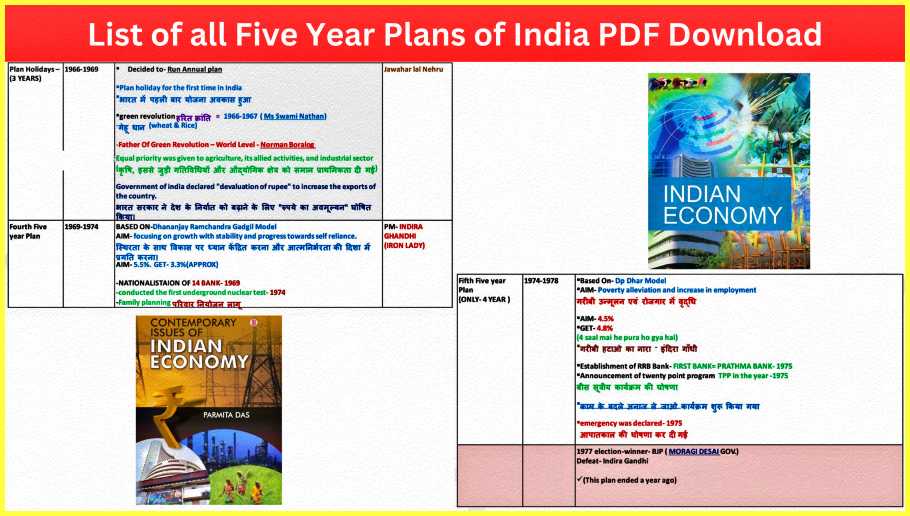
Fourth Five-Year Plan: The Quest for Expansion and Self-Sufficiency
The Fourth Five-Year Plan, led by Prime Minister Indira Gandhi (1969-1974), had a dual focus on expansion with stability and gradual self-sufficiency. It saw the nationalization of 14 major Indian banks and a renewed emphasis on the Green Revolution. However, the conflict with Pakistan due to the Bangladesh crisis hampered economic growth, resulting in an achievement of only a 3.3% growth rate against a target of 5.7%.
Here’s the information presented in the form of a table for the Fourth Five-Year Plan (1969-1974) in India:
| Aspect | Details |
|---|---|
| Duration | 1969-1974 |
| Prime Minister | Indira Gandhi served as the Prime Minister during the Fourth Five-Year Plan period. |
| Planning Model | The plan was based on the Gadgil formula, focusing on growth, stability, and economic independence. |
| Main Objective | The primary goal was to reverse the trend of economic concentration and promote growth while maintaining stability and moving toward self-reliance. |
| Key Initiatives | – Bank Nationalization: The administration nationalized 14 major Indian banks, aiming to strengthen the banking sector and promote financial inclusion.
– Agricultural Revolution: The Green Revolution was promoted, leading to significant advancements in agricultural productivity and output. – Conflict Challenges: Funds initially allocated for industrial development were diverted due to the Bangladesh Liberation War and the Indo-Pakistan War in 1971. – Buffer Stock: The concept of a buffer stock emerged, planning a reserve of 5 million tonnes of food grains to ensure food security. – Drought Prone Area Program (DPAP): Introduced to address challenges in drought-prone regions, focusing on agricultural development and water conservation. – Economic Growth Target: The plan aimed for a growth rate of 5.6%, although the achieved growth rate was 3.3% due to various challenges. |
| Outcome and Challenges | Despite challenges posed by regional conflicts and diverted resources, the Fourth Five-Year Plan witnessed significant progress in the agricultural sector through the Green Revolution. The nationalization of banks aimed to strengthen the financial sector. Challenges such as conflict-related fund diversion and achieving the targeted growth rate were encountered, showcasing the complexities of economic planning during this period. |
The Fourth Five-Year Plan marked a period of economic transformation, focusing on agricultural advancements, financial sector reforms, and addressing regional challenges. Despite obstacles, the plan laid the groundwork for India’s economic resilience and self-reliance efforts.
Fifth Five-Year Plan: Prioritizing Welfare and Development
Introduced in 1974 and continued until 1978, the Fifth Five-Year Plan, led by Indira Gandhi’s government, placed a strong emphasis on welfare schemes, employment, justice, agricultural output, and defense. Notably, India underwent the “Emergency” period from 1975 to 1976, and several significant reforms were introduced, resulting in a 4.8% growth rate against a 4.4% target.
Here’s the information presented in the form of a table for the Fifth Five-Year Plan (1974-1978) in India:
| Aspect | Details |
|---|---|
| Duration | 1974-1978 |
| Main Emphasis | The plan strongly emphasized justice, employment, and poverty eradication (Garibi Hatao). It aimed to achieve economic equity and uplift the impoverished sections of society. |
| Focus Areas | – Poverty Eradication: Significant efforts were made to reduce poverty and improve the living standards of the underprivileged.
– Independence in Defense: Emphasis on achieving self-reliance and independence in the defense sector. – Agricultural Output: Focus on enhancing agricultural output and ensuring food security for the nation. |
| Key Legislation | In 1975, the Electricity Supply Act became law, facilitating regulations and standards in the electricity sector to enhance energy infrastructure. |
| Policy Rejection | In 1978, the concept of the plan, including the emphasis on Garibi Hatao, was rejected by the Morarji Desai cabinet, leading to shifts in policy direction. |
| Targeted Growth Rate | The plan aimed for a growth rate of 4.4%, reflecting the ambitious economic targets set to promote equitable development. |
| Achieved Growth Rate | The plan achieved a growth rate of 4.8%, slightly exceeding the targeted rate, indicating progress in economic development initiatives. |
The Fifth Five-Year Plan demonstrated a strong commitment to social justice, poverty eradication, and economic independence. Despite challenges and shifts in policy direction, the plan’s focus on equitable development contributed to India’s efforts in uplifting marginalized communities and fostering economic growth.
Rolling Plan: Flexibility and Adaptation
The Rolling Plan, introduced by the Morarji Desai government in 1978, provided flexibility by allowing adjustments to targets, projections, and allocations based on the evolving economic landscape. This approach aimed to address the prevailing conditions and circumstances effectively.
Here’s the information presented in the form of a table for the Rolling Plan (1978-1980) in India:
| Aspect | Details |
|---|---|
| Duration | Flexible duration spanning 3, 4, or 5 years (1978-1980) with perspective planning for 10, 15, or 20 years. |
| Introduction Reason | Introduced in response to the rejection of the Fifth Five-Year Plan. |
| Key Features | – Flexible Duration: Allowed for adaptability with varying plan durations.
– Perspective Planning: Long-term planning for 10, 15, or 20 years for a broader vision. – Scheme Introduction: Three schemes were introduced for the current year’s budget. – Target Adjustments: Goals, funding, and projects could be adjusted based on economic needs. – Stability Requirement: Targets needed to remain stable to prevent economic destabilization. |
| Advantages | – Flexibility in goal revision and funding adjustments.
– Adaptability to changing economic requirements. – Long-term perspective for comprehensive planning. – Prevention of economic destabilization through stable targets. |
| Transition to New Plans | A new five-year plan was introduced after the Indian National Congress rejected the previous plan in 1980, marking a transition from the Rolling Plan approach. |
The Rolling Plan represented a shift in India’s planning methodology, emphasizing flexibility, adaptability, and long-term vision while addressing immediate economic needs. Its dynamic nature allowed the government to respond effectively to economic challenges, ensuring stability and growth in the nation’s development efforts.
Sixth Five-Year Plan: Embracing Economic Liberalization
Under the leadership of Indira Gandhi (1980-1985), the Sixth Five-Year Plan was geared towards economic liberalization, technological self-sufficiency, and poverty eradication. The plan aimed for a 5.2% growth rate and remarkably achieved a growth rate of 5.7%.
Here’s the information presented in the form of a table for the Sixth Five-Year Plan (1980-1985) in India:
| Aspect | Details |
|---|---|
| Duration | 1980-1985 |
| Key Economic Shift | The Sixth Five-Year Plan marked the end of Nehruvian socialism and the initiation of economic liberalization in India. It signaled a shift toward market-oriented policies. |
| Population Control | Family planning initiatives were intensified to address population growth, aiming for a reduction in the population growth rate. |
| Targeted Growth Rate | The plan aimed for a growth rate of 5.2%, reflecting the economic goals set to promote development and stability. |
| Achieved Growth Rate | The plan achieved a growth rate of 5.7%, surpassing the targeted rate, indicating successful economic performance during this period. |
| Notable Achievement | The Sixth Five-Year Plan holds the distinction of being the only five-year plan completed twice, emphasizing its significance and impact on India’s economic trajectory. |
| Impact and Legacy | The plan’s shift from Nehruvian socialism to economic liberalization laid the foundation for India’s later economic reforms in the 1990s. It marked a significant step toward market-oriented policies and paved the way for rapid economic growth in subsequent years. |
The Sixth Five-Year Plan represented a crucial turning point in India’s economic policies, ushering in a new era of economic liberalization and setting the stage for extensive reforms that would drive the country’s economic growth and development in the coming decades.
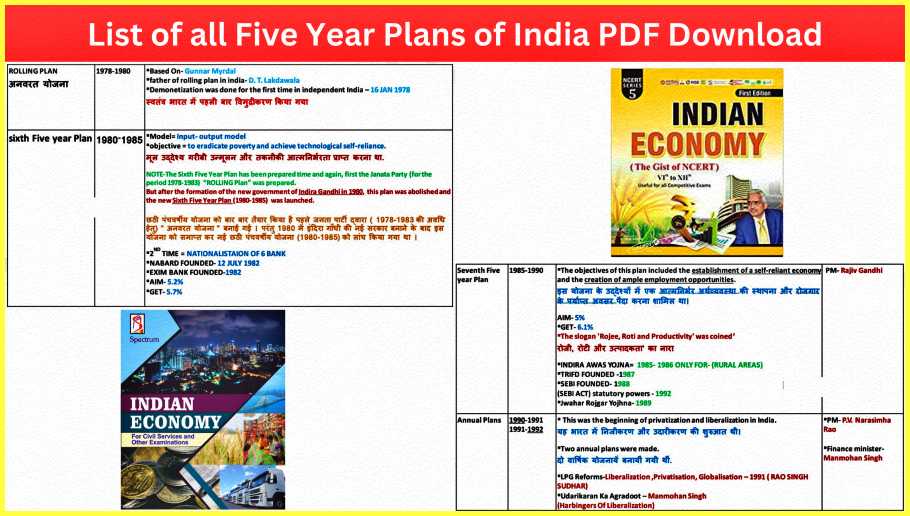
Seventh Five-Year Plan: Prioritizing Self-Sufficiency and Technology
Rajiv Gandhi’s tenure saw the execution of the Seventh Five-Year Plan (1985-1990), which focused on self-sufficiency, technological development, and enhanced employment opportunities. Notably, this plan marked a shift toward prioritizing the private sector over the public sector. India achieved a 6.0% growth rate, exceeding the targeted 5.0%.
Here’s the information presented in the form of a table for the Seventh Five-Year Plan (1985-1990) in India:
| Aspect | Details |
|---|---|
| Duration | 1985-1990 |
| Prime Minister | Implemented under the direction of Prime Minister Rajiv Gandhi. |
| Key Objectives | – Development of a self-sufficient economy.
– Creation of employment opportunities. – Modernization of technology and industries. – Emphasis on private sector development over the state for the first time. |
| Targeted Growth Rate | The plan set a growth target of 5.0% as a goal for economic development during the period. |
| Achieved Growth Rate | The plan surpassed expectations, achieving a growth rate of 6.01%, indicating successful implementation of economic policies and initiatives. |
The Seventh Five-Year Plan under Rajiv Gandhi’s leadership marked a period of significant economic growth and modernization in India. The emphasis on self-sufficiency, employment generation, and technological advancement, coupled with a proactive approach towards the private sector, contributed to the plan’s success in achieving a growth rate higher than the targeted rate.
Annual Plans: Tackling Economic Challenges
Amidst political volatility, India implemented two annual plans in 1990-91 and 1991-92 to boost its economy, which was opening up to international trade and services.
Here’s the information presented in the form of a table for the Annual Plans (1990-1992) in India:
| Aspect | Details |
|---|---|
| Duration | 1990-1991 and 1991-1992 |
| Reason for Annual Plans | The highly charged political environment and challenges prevented the implementation of the Eighth Five-Year Plan. Two yearly plans were adopted instead. |
| Planning Approach | Shifted to Annual Plans, allowing for more flexibility and adaptability in economic policies. |
| Focus and Flexibility | Each year was planned separately, enabling the government to assess economic conditions annually and make necessary adjustments in policies and initiatives. |
| Challenges Addressed | Political instability and economic uncertainties necessitated a dynamic approach to economic management, ensuring adaptability to changing conditions. |
The adoption of Annual Plans during this period exemplified India’s ability to respond effectively to political and economic challenges, allowing for a more responsive and flexible approach to economic management.
Eighth Five-Year Plan: A Focus on Human Resources
The Eighth Five-Year Plan (1992-1997), executed during P.V. Narasimha Rao’s leadership, emphasized human resources development, including education, employment, and public health. The plan successfully achieved an annual growth rate of 6.8% against a target of 5.6%.
Here’s the information presented in the form of a table for the Eighth Five-Year Plan (1992-1997) in India:
| Aspect | Details |
|---|---|
| Duration | 1992-1997 |
| Key Achievements | Modernization of industries stood out as a significant accomplishment during the Eighth Five-Year Plan. |
| International Trade | On January 1, 1995, India joined the World Trade Organization, signifying increased participation in global trade. |
| Primary Goals | – Controlling population growth.
– Reducing poverty and unemployment. – Strengthening institutional building. – Managing tourism. – Developing human resources. – Involving NGOs, Panchayati Raj, Nagar Palikas, and local governments. – Decentralization of governance. – Prioritizing energy, constituting 26.6% of the budget allocation. |
| Targeted Growth Rate | The plan aimed for a growth rate of 5.6% as a goal for economic development during the period. |
| Achieved Growth Rate | The plan exceeded expectations, achieving a growth rate of 6.8%, indicating successful implementation of economic policies and initiatives. |
The Eighth Five-Year Plan showcased India’s focus on industrial modernization, international trade engagement, poverty reduction, employment generation, and energy development. Achieving a growth rate of 6.8% highlighted the plan’s success in addressing these objectives and fostering economic progress during this period.
Ninth Five-Year Plan: Pursuing Growth with Social Justice
Under the leadership of Atal Bihari Vajpayee, the Ninth Five-Year Plan (1997-2002) aimed at “Growth with Social Justice and Equality.” While the targeted growth rate was 6.5%, the achieved growth stood at 5.6%.
Here’s the information presented in the form of a table for the Ninth Five-Year Plan (1997-2002) in India:
| Aspect | Details |
|---|---|
| Duration | 1997-2002 |
| Prime Minister | Atal Bihari Vajpayee served as the Prime Minister of India during the Ninth Five-Year Plan period. |
| Significance | Implemented after 50 years of Indian Independence, marking a period of significant development efforts in the nation. |
| Key Themes | – Emphasis on citizen participation in development initiatives in both rural and urban areas.
– Focus on the relationship between rapid economic growth and the quality of life for citizens, addressing social and economic disparities. – Integration of general public and governmental organizations into the development process. |
| Targeted Growth Rate | The plan aimed for a growth rate of 7.1%, reflecting ambitious economic goals to foster development and progress. |
| Achieved Growth Rate | The plan achieved a growth rate of 6.8%, indicating notable progress but falling slightly below the targeted rate. |
The Ninth Five-Year Plan underscored the importance of inclusive development, citizen participation, and the improvement of the quality of life for all citizens. Despite challenges, the plan made significant strides in addressing social and economic disparities and contributed to the overall progress of the nation.
Tenth Five-Year Plan: Aiming for Poverty Reduction
The Tenth Five-Year Plan (2002-2007), spanning two Prime Ministers, Atal Bihari Vajpayee and Manmohan Singh, sought to double India’s per capita income and reduce poverty rates by 15% by 2012. The plan aimed for an 8.0% growth rate but achieved 7.6%.
Here’s the information presented in the form of a table for the Tenth Five-Year Plan (2002-2007) in India:
| Aspect | Details |
|---|---|
| Duration | 2002-2007 |
| Key Goals | – Achieve an annual GDP growth of 8%.
– Reduce the poverty rate by 5% by 2007. – Generate well-paying, high-quality jobs for the additional labor force. – Reduce pay and literacy inequalities between men and women by at least 50% by 2007. |
| Strategic Approach | Adopted a regional strategy to reduce regional inequities, emphasizing a more balanced development approach across different regions of the country. |
| Performance Criteria | Implemented a 20-point system to assess progress and performance against the set goals and targets. |
| Targeted Growth Rate | The plan set a growth target of 8.1%, aiming for robust economic development and progress during the period. |
| Achieved Growth Rate | The plan achieved a growth rate of 7.7%, indicating substantial economic growth but falling slightly below the targeted rate. |
The Tenth Five-Year Plan emphasized balanced regional development and aimed at achieving significant economic growth while focusing on poverty reduction, job creation, and reducing gender disparities. Despite challenges, the plan made substantial strides in these areas, contributing to India’s overall development during this period.
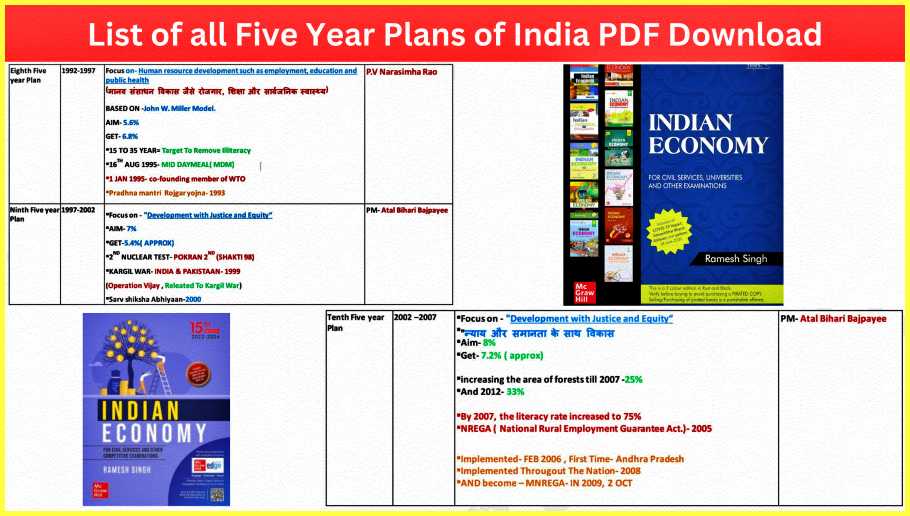
Eleventh Five-Year Plan: Pursuing Inclusive Growth
Under the leadership of Prime Minister Manmohan Singh (2007-2012), the Eleventh Five-Year Plan aimed for rapid and inclusive growth. The achieved growth rate was 8.0%, just shy of the 9% target.
Here’s the information presented in the form of a table for the Eleventh Five-Year Plan (2007-2012) in India:
| Aspect | Details |
|---|---|
| Duration | 2007-2012 |
| Prime Minister | Manmohan Singh served as the Prime Minister of India during the Eleventh Five-Year Plan period. |
| Key Objectives | – Increase the enrollment of 18–23-year-olds in higher education by 2011–12.
– Focus on the confluence of formal, non-formal, remote, and IT education institutions. – Quick and inclusive expansion with a focus on poverty reduction. – Strengthen the social sector and improve service delivery. – Empowerment through education and skill-building initiatives. – Promote gender equality and increase the rate of gender empowerment. – Achieve growth rates of 4% in agriculture, 10% in industry, and 9% in services. – Lower the overall fertility rate to 2.1. |
| Education Emphasis | The plan emphasized increasing the enrollment of young adults in higher education and integrating various forms of education, including formal, non-formal, remote, and IT-based learning. |
| Economic Growth Targets | The plan aimed at achieving growth rates of 4% in agriculture, 10% in industry, and 9% in services sectors to foster economic development. |
| Social Empowerment | Social empowerment through education and skill-building programs, coupled with a focus on gender equality, was a crucial aspect of the plan. |
| Population Control | The plan aimed to lower the overall fertility rate to 2.1 as a part of population control initiatives. |
The Eleventh Five-Year Plan focused on holistic development, emphasizing education, economic growth, social empowerment, and population control measures. Its multifaceted approach aimed to create a more inclusive and sustainable development trajectory for India during this period.
Twelfth Five-Year Plan: Fast, Inclusive, and Sustainable Growth
The Twelfth Five-Year Plan (2012-2017), under the guidance of Prime Minister Manmohan Singh, was designed to achieve faster, inclusive, and sustainable growth, marking India’s ongoing quest for comprehensive economic development.
Here’s the information presented in the form of a table for the Twelfth Five-Year Plan (2012-2017) in India:
| Aspect | Details |
|---|---|
| Duration | 2012-2017 |
| Growth Rate Target | Aimed to attain an 8.2% growth rate in India’s economy during the plan period. |
| Government Approval | On December 27, 2012, the National Development Council (NDC) approved an 8% growth rate for the Twelfth Five-Year Plan. |
| Infrastructure Development | Focused on improving the nation’s infrastructure initiatives to ensure sustained economic growth and prevent congestion. |
| Employment Generation | Aimed to generate 50 million new jobs in non-farm industries, promoting employment opportunities and economic inclusivity. |
| Higher Education Access | Aimed to expand accessibility to higher education, fostering educational opportunities for a larger section of the population. |
| Electricity Access | Planned to supply electricity to all villages, ensuring universal access to this essential resource. |
| Safe Drinking Water | Targeted to provide safe drinking water to half of the non-rural area residents, addressing water quality disparities. |
| Gender and Social Gap | Aims to eliminate the gender and social admissions gap, ensuring equal opportunities in education and employment. |
| Malnutrition Addressal | Addressing malnutrition issues among children aged 0 to 3, focusing on their health and well-being. |
| Green Cover Expansion | Aimed to increase the annual green cover by 1 million hectares, promoting environmental conservation and sustainability. |
| Financial Inclusion | Planned to enable 90% of households to access financial services, fostering financial inclusion and economic stability. |
The Twelfth Five-Year Plan emphasized a comprehensive approach to economic development, addressing various sectors including education, healthcare, infrastructure, and environmental conservation, aiming to create a more inclusive and sustainable future for India.
So, These historical Five-Year Plans provide valuable insights into India’s journey toward economic progress and societal well-being, with each plan reflecting the nation’s evolving priorities and strategies.
Table: Achievements of the Five-Year Plans
Here is the Table of Significant achievements of the Five-Year Plans include:
Here’s the information presented in the form of a summarized table for the achievements of the Five-Year Plans in India:
| Achievements | Details |
|---|---|
| Increase in National Income | India’s national income grew at an average rate of around 5% annually during the planning period, significantly surpassing pre-planning growth. |
| Per Capita Income Growth | Per capita income exhibited notable growth, increasing at an annual rate of 2.9%, indicating improved living standards for the population. |
| Agricultural Advancements | Institutional and technical advancements led to an annual agricultural output growth rate of 2.8%, contributing to agricultural sector development. |
| Industrial Expansion and Diversification | Industrial production grew at an annual rate of approximately 7%, with significant expansion in industries producing essential goods. |
| Economic and Social Infrastructure Development | Financial, insurance, transportation, communication, irrigation, power infrastructure, and health and education services saw substantial growth. |
| Job Creation | Targeted efforts led to the creation of employment opportunities, with a goal of generating 58 million jobs in the eleventh five-year plan. |
| Foreign Trade Expansion | India’s international trade expanded significantly, with the value of international commerce reaching substantial levels, reflecting global integration. |
These achievements highlight the remarkable progress made by India during the planned periods, contributing to economic growth, infrastructure development, employment generation, and enhanced global trade relations.
Table: Failures of the Five-Year Plans
Here’s the information presented in the form of a summarized table for the failures and challenges faced during the implementation of the Five-Year Plans in India:
| Failures and Challenges | Details |
|---|---|
| Poverty Alleviation | Despite being a primary goal, the plans struggled to significantly reduce poverty, leading to persistent poverty issues and income disparities. |
| Unemployment and Inflation | High unemployment rates and soaring inflation levels contributed to economic instability and financial strain on the population. |
| Economic Disparities | Efforts to achieve equitable sharing of social and economic gains fell short, resulting in widening gaps between different socioeconomic classes. |
| Infrastructure Challenges | Inadequate infrastructure hindered economic growth and development, making vulnerable populations more excluded from essential services. |
| Inequities and Vulnerability | Desired outcomes to address inequities were not effectively achieved, leaving vulnerable populations facing challenges in accessing basic amenities and opportunities. |
These challenges underscore the need for targeted policies, comprehensive social programs, and strategic investments in infrastructure and education to address the disparities and vulnerabilities within society and promote inclusive and sustainable development.
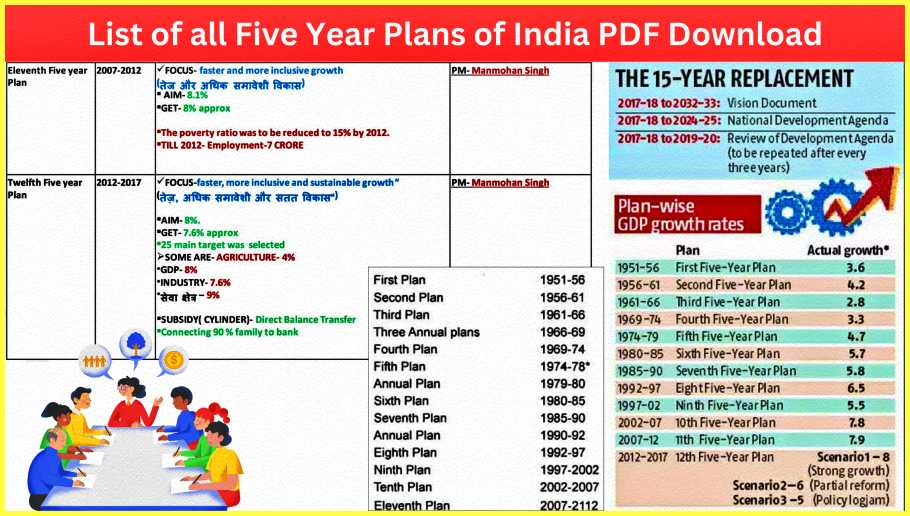
What is NITI Aayog?
NITI Aayog, or the National Institution for Transforming India, is a policy think tank and a premier policy-making body of the Government of India. Established in January 2015, it replaced the Planning Commission (Five-Year Plans), marking a shift from a centralized planning approach to a more decentralized and cooperative federal structure.
Here are the key aspects of NITI Aayog:
- Role and Objectives: NITI Aayog serves as a platform to facilitate cooperative federalism in India by involving states in the economic policy-making process. It aims to foster sustainable and inclusive growth by focusing on various sectors and initiatives.
- Advisory Body: NITI Aayog acts as an advisory body, offering recommendations and policy inputs to the central and state governments. It advises on matters related to economic development, policy formulation, and strategic issues.
- Decentralized Approach: Unlike the Planning Commission, NITI Aayog does not create centralized plans for the entire country. Instead, it encourages states to formulate their own policies and plans, tailoring them to their specific needs and priorities.
- Involvement of States: All Chief Ministers of states and Union territories, along with the Prime Minister, serve as members of the governing council of NITI Aayog. This inclusive approach ensures active participation and cooperation between the central government and the states.
- International Engagement: NITI Aayog aligns its policies and initiatives with international frameworks, such as the Sustainable Development Goals (SDGs), to promote sustainable development in India. It collaborates with international organizations and forums to achieve these goals.
- Leadership: The Prime Minister of India serves as the chairman of NITI Aayog. It is led by a full-time CEO and includes other experts and officials who work towards developing innovative policy solutions.
NITI Aayog’s establishment marked a significant shift in India’s approach to policy-making, emphasizing collaboration, flexibility, and sustainable development. While the traditional Five-Year Plans have ceased, NITI Aayog plays a crucial role in shaping India’s economic and developmental policies in the modern context.
Conclusion,
- After gaining independence in 1950, India embarked on a crucial journey of economic development through meticulous planning. The Planning Commission (1951-2014) and subsequently, the NITI Aayog, became instrumental in formulating, executing, and monitoring the nation’s economic strategies. These entities implemented a series of Five-Year Plans, focusing on balanced growth, industrialization, poverty reduction, and social welfare. The plans laid the foundation for India’s progress, emphasizing key sectors and infrastructure. While the traditional Five-Year Plans concluded in 2017, the shift to the decentralized and cooperative federalism model of NITI Aayog underscores India’s adaptability and commitment to inclusive, sustainable development. This continuous effort reflects India’s determination to uplift its citizens and build a prosperous future for the nation.
- India’s Five-Year Plans stand as a testament to the nation’s resilience, adaptability, and determination. From the early days of independence to the era of globalization, these plans guided India’s growth, shaping it into the vibrant democracy and economic giant it is today. While the traditional plans have evolved, their spirit lives on in the progressive policies, innovative initiatives, and inclusive development strategies that continue to shape India’s future. As the nation marches forward, the legacy of these plans remains an enduring beacon, illuminating the path to a brighter, more prosperous tomorrow.
Also Read:
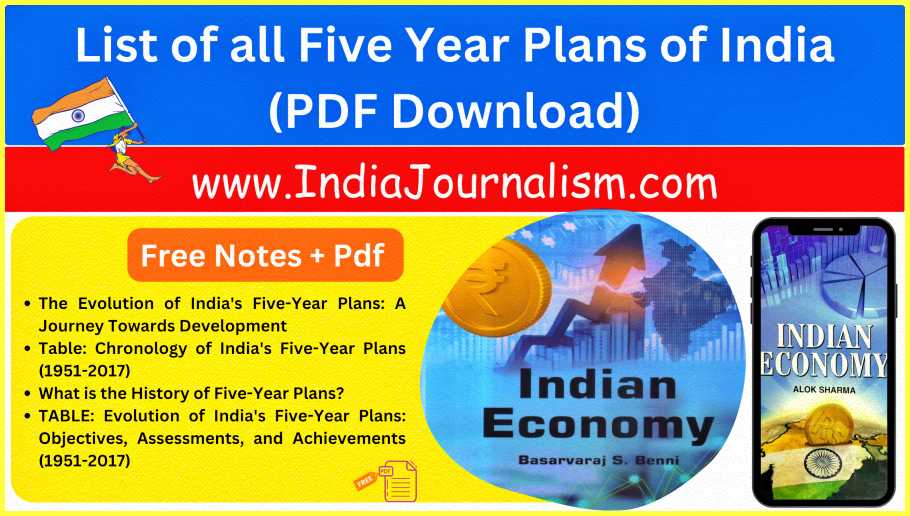



Hello there